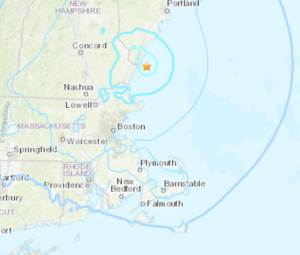
Point Gammon Lighthouse from just after the turn of the 20th century, courtesy of Jeremy D’Entremont.
Great Island, located on Nantucket Sound in West Yarmouth, is perhaps the most exclusive area on Cape Cod. The 700-acre area, which is technically connected to the rest of the Cape at low tide, is privately owned and dotted with multi-million dollar homes owned by some big time players. It is next to impossible to make your way out to the southern tip of Great Island due to the layers of security. That is a shame as standing stoically and usually in complete solitude is a wonderful piece of living Cape Cod history that only a select few have been able to see up close. It is Point Gammon Lighthouse and this is its story.
Today Great Island is off limits to just about everyone, however two centuries ago it was uninhabited by just about everyone. Back then it was completely open land used by Yarmouth residents for cattle pasture. Jutting out more than a mile into the ocean the sometimes-island became home to a smallpox inoculation hospital in 1802 after an outbreak which had begun in 1797. Due to its proximity the hospital was relatively secluded. The area of Great Island where the hospital was located was named Point Gammon. The waters just offshore are dotted with dangerous boulders which caused numerous shipwrecks. Its name would come from the game of backgammon as sailors were often ‘gammoned’ or deceived by the submerged boulders.
This constant threat of shipwreck as well as the increased traffic into Hyannis Harbor led to the construction of a lighthouse at the tip of Great Island in 1816. Standing twenty-five feet tall and made of stone it would be named Point Gammon Lighthouse. The tower would help but as time went on the vessel traffic continued to increase and the landlocked lighthouse was seen as inadequate. In 1855 lighthouse keeper John Peak noted a total of 4,969 schooners, 1,455 sloops, 216 brigs, and four steamboats which passed Point Gammon during the year. These numbers made it necessary for a lightship to be stationed further off shore. The spot chosen was close to a pair of rocky ledges known as Bishop and Clerks more than two miles from the shores of Great Island. In 1858 this was replaced by a permanent structure known as Bishop and Clerks Lighthouse. Upon its creation Point Gammon Lighthouse was deactivated and Great Island went dark.
The story of Great Island began to change in 1872 when the land was purchased by Samuel Payson of the prominent import-export J.C. Howe & Co. out of Boston. Payson would be the first to construct a summer home on the peninsula. The land would be sold to wealthy ornithologist Charles Cory in 1883 who would make some major changes. Cory would be the first to make Great Island private. He did so by placing a gate at the entrance to the property, and doubled-down on it by constructing a six-foot tall fence around its entirety. Inside the fence Cory created a rare game preserve and a hundred acre golf course. Cory would spend more than $100,000 ($2.5 million in 2017) on improving the property between 1883-1907. This included the creation of a grand hotel called Aberdeen Hall.
After spending much of his time on Great Island for nearly thirty years Cory gave all but fifty acres of the property away to a corporation in 1911. The land would end up in the control of Henry Phipps, a New York steel tycoon in 1916. It would in turn be sold to Malcolm Chace and to this day much of Great Island remains owned by the Chace Family.
Today Great Island remains one of the most exclusive areas on Cape Cod. Point Gammon Lighthouse has been deactivated for more than 150 years yet still stands stoically looking over the Nantucket Sound waters that it used to protect. The keeper’s house was eventually taken down in the years around World War I with the materials used to build another dwelling. Bishop and Clerks Lighthouse, the bacon which replaced Point Gammon Light, stood tall out in the sound for nearly a century before falling into disrepair and being demolished in 1952. Point Gammon Lighthouse being at the tip of the highly private Great Island is for all intents and purposes off limits. One can see it from the nearby Keyes Beach in Hyannis, and Craigville Beach in Centerville, or you may traverse the boulder laden coast by boat. However up close visits are not likely and should not be attempted.
By Christopher Setterlund


























